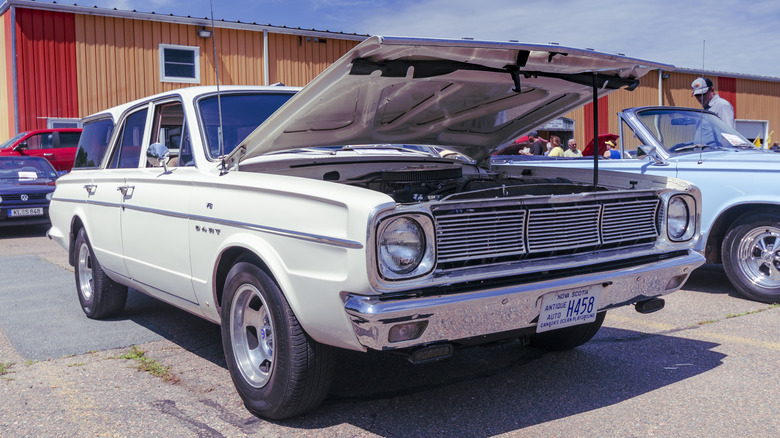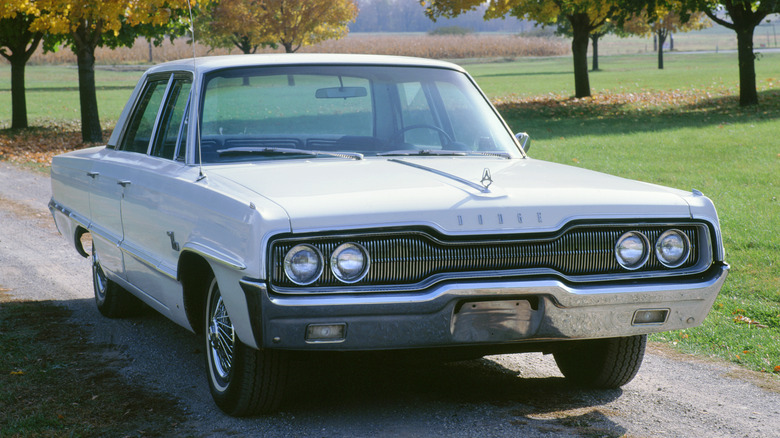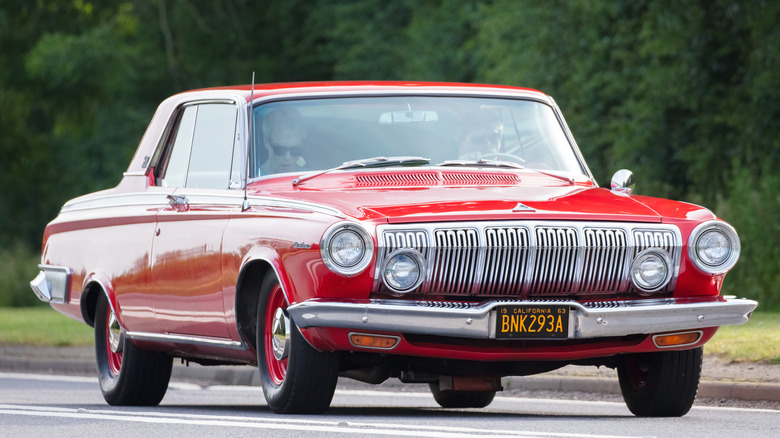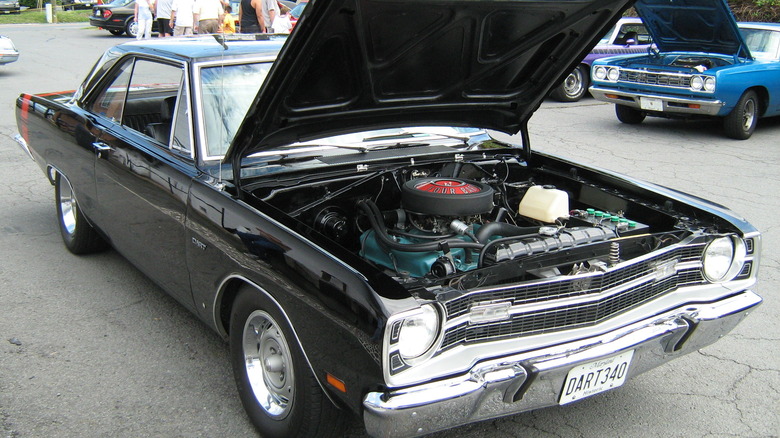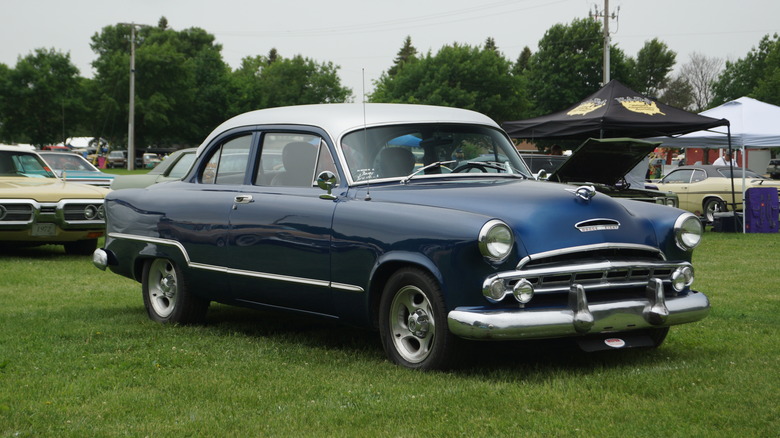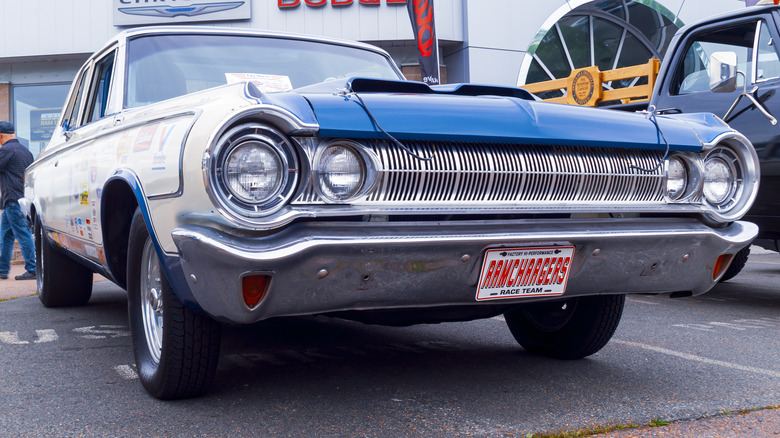5 Totally Underrated Dodge Muscle Cars
Michigan natives Horace and John Dodge started off building bicycles and auto parts before starting their own car company in 1914. According to Dodge Garage, the Dodge Brothers built just 249 cars that first year, but by 1919, the company's production had expanded to more than 100,000 units a year, including commercial, military, and civilian trucks. The 1920 flu pandemic took the lives of both brothers, but by then, the Dodge brand was the second-best selling car in the country.
Dodge thrived during the muscle car era, with legendary models like the Charger and Challenger making their first appearances in 1966 and 1970, respectively. The latter went on hiatus from 1983 through 2008, but Dodge produced an impressive V10-powered special edition Challenger in 2010. The Charger lost its muscle car pedigree in the 1980s when its beefy V8s were ditched for a pair of 2.2 liter four-cylinder engines, but a 2006 update saw the return of the hemi engine and an aggressively styled redesign. The latest versions of the Charger and Challenger get plenty of attention, particularly the 6.2 liter hemi-powered SRT versions. This includes the 700-plus horsepower Hellcat and racetrack-only Hellephant, which has an engine rated at an unholy 1,000 horsepower.
In its heyday, Dodge also made some formidable muscle cars which could actually be driven on public roads, and they deserve more than to be relegated to the footnotes and margins of Dodge's impressive catalog of vehicles.
Monaco
Dodge produced the Monaco in four separate generations between 1965 and 1992, with a long break between the end of the third generation in 1978 and the badge's revival in 1990. The first-gen Monaco was developed in response to the wildly successful Pontiac Grand Prix, which debuted in 1963 with a production run of almost 73,000 units. Chrysler exec Gene Weis told How Stuff Works that the Monaco was a pointed answer to the success of the Grand Prix. "We spent money on every aspect of our 1965 cars, adding content to best the competition," he said, "targeting GM." First-year American buyers could choose between three V8 engines ranging from 383 to 426 cubic inches, although Canadian customers also had the option of a 225-inch Slant Six and a convertible body style not available in the United States. Dodge sold 13,096 Monacos in 1965, far fewer than the 57,900 Grand Prixs or 44,900 Plymouth Grand Sport Furies that left dealership lots that year.
The second generation Monaco debuted in 1974, just as the oil crisis was taking a huge chunk out of full-sized car sales in the United States. The model remained popular with police forces, though, and its ubiquity as a squad car made it a staple for television and movie producers in the '70s and '80s. The de-commissioned police car driven by Jake and Elwood Blues in the original "Blues Brothers" film was a '74 Monaco, and '77 Monacos were used by law enforcement in "The Terminator" and on "The Dukes of Hazzard."
Polara
The Polara first appeared in 1960, but sales dipped by half the following year, so the model was downsized for 1962. Second-generation Polaras existed in the netherworld between luxury and performance machine, with a crowded instrument panel and 5.9 liter V8 under the hood. The front end had two headlights on the grille and two in the standard position on the leading edge of the fenders, and the quirky design was changed slightly each year from 1962 through 1964. The Polara's overall styling was regarded as odd by many of the brand's loyalists, and Dodge design exec Bob Gale told How Stuff Works that when he took a Polara 500 convertible to Colorado "no one knew what kind of car it was," adding, "They'd never seen one like it."
While the Polara may be too weird to be duly loved, it certainly has proper muscle car chops. A 1964 Polara 500 with a Max Wedge big block V8 was featured on an episode of "Jay Leno's Garage." "This would be the equivalent, I think, of a Hellcat today," Leno said. "Basically, a big, comfortable car that's fast."
Dart Swinger 340
The Dart began life as a full-sized car in 1960, and was the first model to get the legendary Slant Six engine that year. It was downsized in 1962, and during the 1964 model year, the Dart GT was introduced, powered by a 273 cubic inch V8. A GTS version came in 1967, with 340 and 383-inch V8s as options. For 1970, the GTS and 383 were dropped, leaving the 340 as the largest engine choice. The loss of cubic inches might look like a problem on paper, but the 340 weighed 90 pounds less than the 383 and the newly rechristened Dart Swinger 340's Hurst shifter and 3.23:1 rear differential were a perfect match for the engine that produced 275 horsepower and 340 pound-feet of torque (via Automobile Catalog).
At less than 3,300 pounds, the 1969 Swinger 340 could go from zero to 60 mph in the low six-second range and cover a quarter mile in under 15 seconds. These numbers put it far ahead of that year's Chevy Impala, which had a 390-horsepower, 427 cubic inch V8. A confusing shuffling of Swinger models came in 1971, when the Plymouth Duster switched brands and became the Dart Demon 340, bumping the Swinger 340 to the side as the renamed Swinger Special. In addition to the disorienting name changes, the Swinger 340 is often overshadowed by its Scat Pack brothers the Super Bee and Charger.
[Featured image by CZMarlin via Wikimedia Commons | Cropped and scaled | Public Domain]
1953-60 Coronet
The Coronet badge first appeared in 1949, and the model got a boost in 1953 with the inclusion of the first-generation hemi V8. That motor produced 140 horsepower and 220 pound-feet of torque (via Top Speed), modest figures by today's standards but impressive for the era. The Coronet earned true muscle car status in 1965, when it was shrunk to a mid-sized model and got bigger engine options, including the new 426 cubic inch hemi and a 375 horsepower 440 cubic inch V8.
The beastliest Coronets were the R/T and Super Bee, both of which first appeared in 1968. Most of those special Coronets were powered by a Magnum version of the 440, which produced 390 horsepower and 490 pound-feet of torque when topped with the "Six-Pack" array of three two-barrel carburetors, according to How Stuff Works. With those dyno numbers, these late-'60s Coronets can hardly be considered underrated or underappreciated, but the seemingly underpowered second-generation models punched well above their weight, setting more than 100 land speed records at the Bonneville Salt Flats in Utah in 1953 alone. 1953-60 models can also still be had for under $20,000, while late '60s examples often fetch $50,000 or more.
[Featured image by Greg Gjerdingen via Wikimedia Commons | Cropped and scaled | CC-By 2.0]
330
The Dodge 330 had a relatively short run, lasting only from 1962 through 1964 in the United States and one extra year in Canada, when the 330 and 440 were replaced by the Polara. The base engine was the 225 cubic inch Slant Six, but V8s ranging from 318 cubic inches to the 426 max wedge were also available as optional equipment. According to Auto Evolution, the 1963 330 Max Wedge with dual four-barrel carburetors and 13.5:1 compression ratio could make a filling-loosening 425 horsepower, but only 34 units left the factory with that configuration.
Even the less powerful versions of the 330 were well-appointed, with a push-button Torqueflite 727 three-speed automatic transmission, a cigarette lighter, and armrests for rear seat passengers. Station wagon versions could carry nine passengers and had a power window in the tailgate. Max Wedge and hemi-powered 330s are coveted by muscle car enthusiasts today, but the 1963 model with the 318 cubic inch V8 could go from zero to 60 mph in 7.5 seconds, thanks to a curb weight of 3,400 pounds (via Automobile Catalog). That was equal to the 0-60 time of the first-ever Ford Mustang, which appeared the next year as a 1965 model (although it is sometimes referred to as a 1964 1/2 because of the late-year release date).
